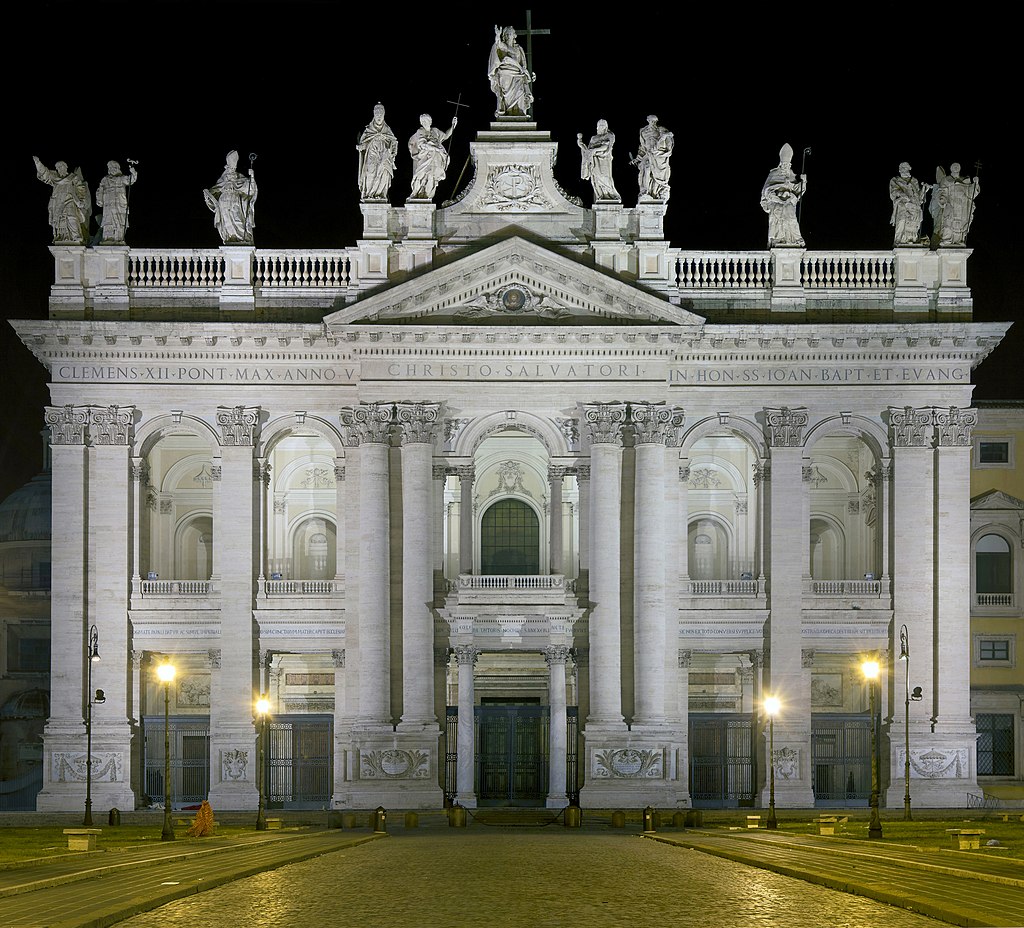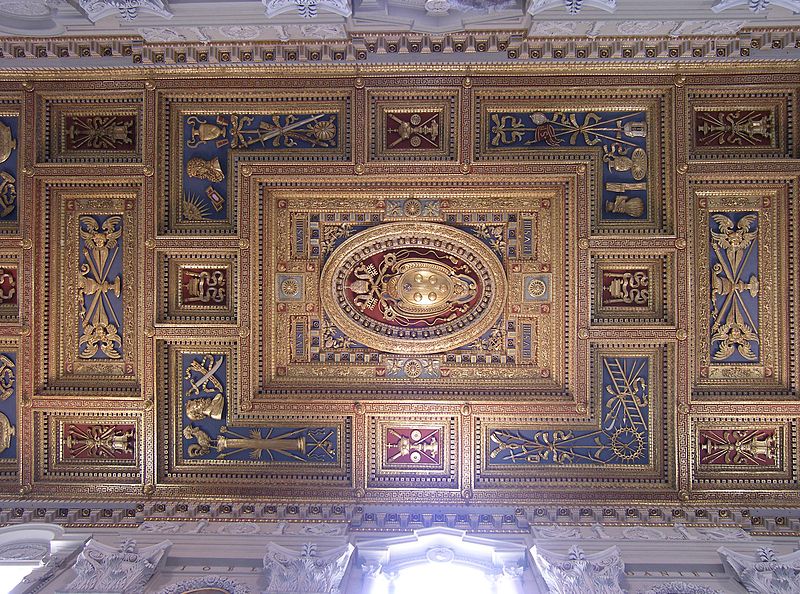Palm Sunday.
Station at Saint John Lateran.
Indulgence of twenty-five Years and twenty-five Quarantines.
Semi-Double.
Privilege of The First Class.
Violet Vestments.
Papal Arch-Basilica of Saint John Lateran.
Archibasilica Sanctissimi Salvatoris et Sanctorum Iohannes Baptistae et
Evangelistae in Laterano Omnium urbis et orbis ecclesiarum mater et caput.
(Rome) par Alessandro Galilei, 1735.
Photo: 2006/09/07.
Source: Own work.
On Palm Sunday is reproduced The Triumphal Procession,
which accompanied Our Lord, when He entered Jerusalem.
Artist: Rene de Cramer.
"Copyright Brunelmar/Ghent/Belgium".
Used with Permission.
In today's Liturgy, the two-fold point of view, from which The Church regards The Cross, is expressed in two Ceremonies. One is marked with joy and the other by sadness.
First, comes The Blessing and Procession of Palms, in which everything overflows with a Holy Joy, which enables us, after two thousand years, to revive the spirit of the magnificent scene of Our Lord's Triumphal Entry into Jerusalem.
Then follows The Mass, whose Chants and Lessons relate exclusively to The Sorrowful Memory of Our Redeemer's Passion.
Photo: October 2005.
(Wikimedia Commons)
The Blessing and Procession of Palms.
At Jerusalem, in the 4th-Century A.D., on the very spot where the event took place, was read the Gospel narrative in which we see Christ hailed as King of Israel and taking possession of His Capital, Jerusalem, which is really no more than the type of Jerusalem, above.
After this, a Bishop, mounted on an ass, rode up to The Church of The Resurrection on the summit of The Mount of Olives, surrounded by a multitude carrying Palms and singing Anthems and Hymns. This Ceremony was preceded by The Solemn Reading of The Passage from Exodus, in which The Flight from Egypt is related.
English: Basilica of Saint John Lateran.
With its length of 400 feet, this Basilica ranks fifteenth among the largest Churches in the World.
Français: Basilique Saint-Jean-de-Latran, Vatican, située à Rome, Latium, Italie. Avec sa longueur de 121,84 mètres, cette Basilique se classe au 15è rang parmi les plus grandes églises au monde.
Photo: September 2010.
Source: Own work.
(Wikimedia Commons)
Papal Arch-Basilica of Saint John-in-Lateran,
Rome, Italy.
Major Papal and Roman Arch-Basilica of The Most Holy Saviour
and Saint John the Baptist and Saint John The Evangelist-in-Lateran.
Mother and Head of all Churches in Rome and in the World.
Photo: 21 April 2015.
Source: Own work.
(Wikimedia Commons)
God's people, encamped under the shadow of the palm trees, near the twelve fountains where Moses promised them the Manna, is a type of the Christian people, who, breaking off branches from the trees, bear witness that God's Son, Jesus, comes to deliver Souls from sin, leading them to the Baptismal Font and nourishing them with the Manna of The Eucharist.
Photo: 2006/09/07.
Source: Own work.
(Wikimedia Commons)
The Church of Rome, it would seem, adopted this practice about the 9th-Century A.D. and added to it the Rite for The Blessing of The Palms, which has given to this Sunday the name of "The Easter of Flowers".
In this Benediction, The Church Prays for health of mind and body for those who dwell in houses where the Palms are preserved.
This Procession of Christians, who, with Palm in hand and songs of Hosanna on their lips, proclaim Christ's Kingship every year, throughout the whole World and in all generations, is composed of all Catechumens, of public penitents and of The Faithful. All of whom will be united at The Easter Feast to this Glorious Victor, through The Sacraments of Baptism, Eucharist and Penance.
The decorated Coffered Ceiling
of the Basilica of Saint John Lateran,
Rome, Italy.
Photo: 27 July 2007.
Source: Own work.
(Wikimedia Commons)
It is this that is represented by the Procession of Palms, when it stops at the door of the Church, into which some Members of the Choir have already found their way. They Chant, alternately with the Clergy; on the one side, "The Angelic Choir", and, on the other, Christ's Soldiers, still plunged in the strife of battle, hailing The King of Glory, each in his turn.
Soon, the door opens, after the Sub-Deacon has knocked on it three times with The Foot of The Cross, and The Procession enters the Church; so does The Cross of Christ open Heaven to us and so will The Elect, one day, enter with their Lord into Eternal Glory.
We should carefully keep a Blessed Palm in our home. It is a Sacramental, which will obtain for us Graces in virtue of The Church's Prayer and strengthen our Faith in Christ, Who, Full of Mercy, has conquered sin, death and the devil, in a victory of which these sacred Palms are the type.
English: The Choir and Apse
in the Basilica of Saint John Lateran,
Rome, Italy.
Deutsch: Chorraum und Apsis
von San Giovanni in Laterano, Rom
Photo: September 2005.
Source: Own work.
(Wikimedia Commons)
The Blessing of Palms takes place at the Basilica of Saint Mary Major (Santa Maria Maggiore), which, in Rome, represents Bethlehem, the birthplace of Him Whom The Magi hailed as "King of the Jews." Thence, The Procession goes to Saint John Lateran, in which Church, in former times, The Lenten Station took place, since, by its Dedication to Saint Saviour, it calls up memories of The Passion, which is the Subject of Today's Mass.






